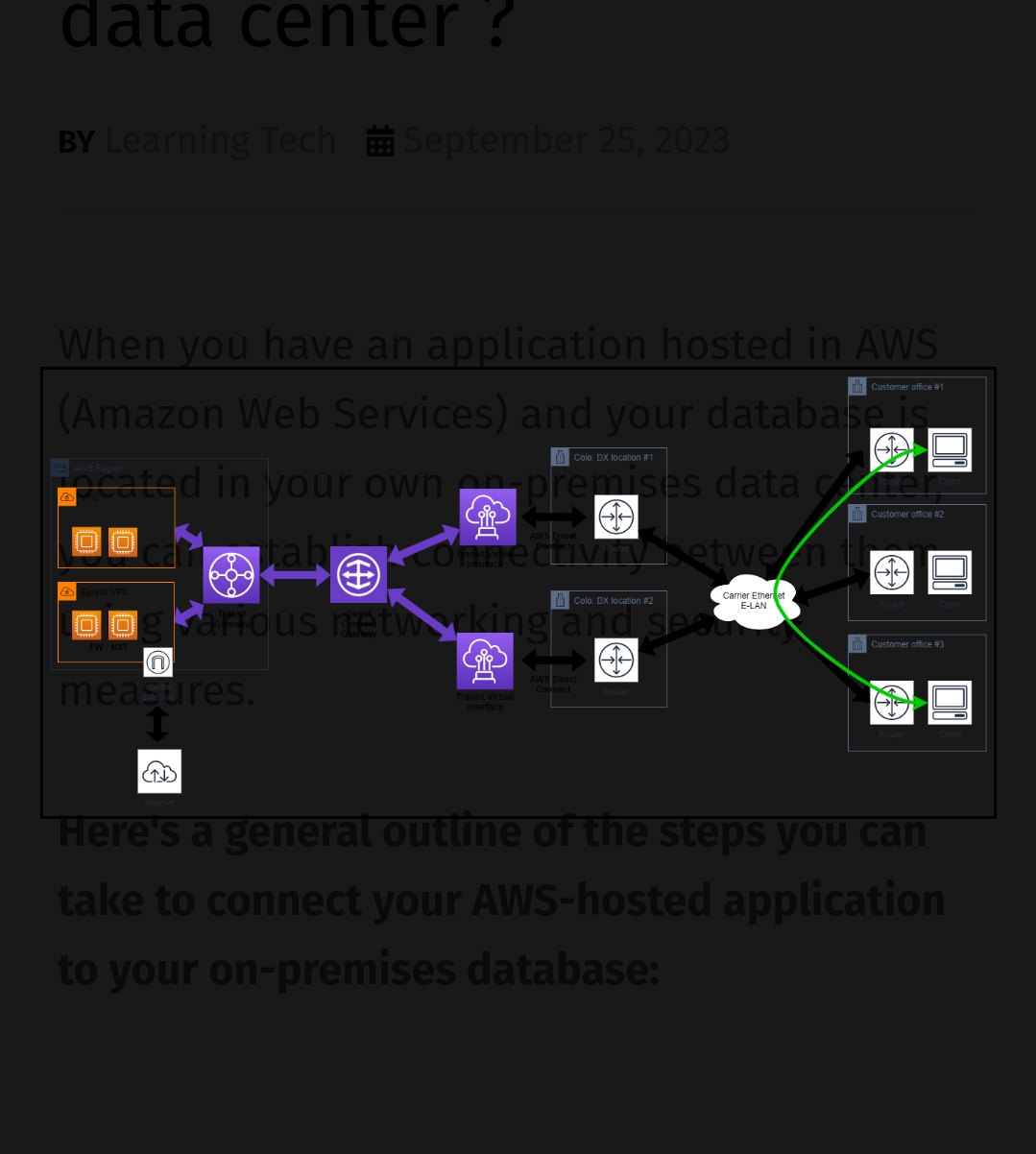How to establish connectivity between an application hosted in AWS (Amazon Web Services) and your database is located in your own on-premises data cen
 Rajesh Kumar
Rajesh Kumar
When you have an application hosted in AWS (Amazon Web Services) and your database is located in your own on-premises data center, you can establish connectivity between them using various networking and security measures.
Here's a general outline of the steps you can take to connect your AWS-hosted application to your on-premises database:-
HomeAWSHow to establish connectivity between an application hosted in AWS (Amazon Web Services) and your database is located in your own on-premises data center ?
How to establish connectivity between an application hosted in AWS (Amazon Web Services) and your database is located in your own on-premises data center ?
Learning TechSeptember 25, 2023
When you have an application hosted in AWS (Amazon Web Services) and your database is located in your own on-premises data center, you can establish connectivity between them using various networking and security measures.
Here's a general outline of the steps you can take to connect your AWS-hosted application to your on-premises database:
1. Assess Network Requirements:-Determine the network requirements for your application to connect to the on-premises database. This includes understanding the required network protocols, ports, and security considerations.
2. Network Connectivity Options :-AWS Direct Connect: Consider setting up an AWS Direct Connect connection to establish a dedicated network link between your on-premises data center and your AWS VPC (Virtual Private Cloud). This provides low-latency, private connectivity.
VPN Connection: Alternatively, you can establish a site-to-site VPN (Virtual Private Network) connection between your on-premises network and your AWS VPC. This allows for encrypted communication over the public internet.
3. Routing Configuration :-Configure the routing tables in your AWS VPC and on-premises network to route traffic between them. Ensure that the routes are correctly set up to direct traffic to the appropriate destinations.
4. Security Groups and Firewall Rules:-Adjust the security group settings for your AWS resources (e.g., EC2 instances) to allow inbound and outbound traffic to and from your on-premises database. Similarly, configure firewall rules on your on-premises network to permit traffic from AWS.
5. Database Configuration :-Ensure that your on-premises database is configured to accept incoming connections from the AWS VPC. Update the database's access control, user accounts, and permissions as needed.
6.Testing and Monitoring :-Thoroughly test the connectivity between your AWS application and the on-premises database to ensure it's functioning as expected. Implement monitoring and logging to detect and troubleshoot any issues that may arise.
7. Security Considerations :-Consider implementing encryption for data in transit between AWS and your on-premises database. You can use SSL/TLS for database connections or encrypt data at the application layer.
8. High Availability and Redundancy :-
Plan for high availability and redundancy in your network configuration to ensure that connectivity remains stable even in the event of failures.
9. Compliance and Security Auditing :-
If your organization has specific compliance requirements, ensure that the connectivity solution meets these standards. Implement security audits and compliance checks as necessary.
10. Documentation and Disaster Recovery:-
Document the entire setup, including network diagrams, configurations, and contact information for responsible personnel. Establish a disaster recovery plan in case of connectivity disruptions.
It's important to note that the specific steps and configurations may vary depending on the AWS services you are using (e.g., EC2, RDS, Lambda) and the type of on-premises infrastructure you have. Always follow AWS and security best practices when setting up connectivity between AWS and on-premises resources to ensure the security and reliability of your application.
#aws
Subscribe to my newsletter
Read articles from Rajesh Kumar directly inside your inbox. Subscribe to the newsletter, and don't miss out.
Written by
